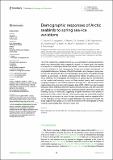Por favor, use este identificador para citar o enlazar a este item:
http://hdl.handle.net/10261/329452COMPARTIR / EXPORTAR:
 SHARE SHARE
 CORE
BASE CORE
BASE
|
|
| Visualizar otros formatos: MARC | Dublin Core | RDF | ORE | MODS | METS | DIDL | DATACITE | |

| Título: | Demographic responses of Arctic seabirds to spring sea-ice variations |
Autor: | Sauser, Christophe; Angelier, Frédéric; Blévin, P.; Chastel, Olivier; Gabrielsen, G.W.; Jouanneau, W.; Kato, Akiko; Moe, Børge; Ramírez Benítez, Francisco CSIC ORCID CVN ; Tartu, S.; Descamps, Sébastien | Palabras clave: | Rissa tridactyla Uria lomvia Alle alle Survival Breeding success Sea-ice concentration Svalbard |
Fecha de publicación: | abr-2023 | Editor: | Frontiers Media | Citación: | Frontiers in Ecology and Evolution 11: 1107992 (2023) | Resumen: | The Arctic experiences a rapid retreat of sea-ice, particularly in spring and summer, which may dramatically affect pagophilic species. In recent years, the decline of many Arctic seabird populations has raised concerns about the potential role of sea-ice habitats on their demography. Spring sea-ice drives the dynamics of phytoplankton blooms, the basis of Arctic food webs, and changes in spring sea-ice have the potential to affect the demographic parameters of seabirds through bottom-up processes. To better understand the effects of spring sea-ice on Arctic seabirds, we investigated the influence of spring sea-ice concentration on the survival and breeding success of three seabird species with contrasted foraging strategies in two Svalbard fjords in the high Arctic. We examined these relationships using long-term demographic data (2005–2021) from black-legged kittiwakes (Rissa tridactyla), Brünnich guillemots (Uria lomvia), and little auks (Alle alle). Spring sea-ice concentration was positively related to both the survival and breeding success of little auks, suggesting a higher sensitivity of this species to spring sea-ice. By contrast, the two other species were not particularly sensitive to changes in spring sea-ice, even though a potentially spurious negative effect on the breeding success of black-legged kittiwakes was observed. Overall, the study suggests that spring sea-ice may be involved in the demography of Arctic seabirds, but probably does not play a major role | Descripción: | 11 pages, 4 figures, 2 tables, supplementary material https://www.frontiersin.org/articles/10.3389/fevo.2023.1107992/full#supplementary-material.-- Data availability statement: The raw data supporting the conclusions of this article will be made available by the authors, without undue reservation | Versión del editor: | https://doi.org/10.3389/fevo.2023.1107992 | URI: | http://hdl.handle.net/10261/329452 | DOI: | 10.3389/fevo.2023.1107992 | E-ISSN: | 2296-701X |
| Aparece en las colecciones: | (ICM) Artículos |
Ficheros en este ítem:
| Fichero | Descripción | Tamaño | Formato | |
|---|---|---|---|---|
| Sauser_et_al_2023.pdf | 1,85 MB | Adobe PDF |  Visualizar/Abrir | |
| Sauser_et_al_2023_suppl.docx | 1,21 MB | Microsoft Word XML | Visualizar/Abrir |
CORE Recommender
SCOPUSTM
Citations
2
checked on 25-abr-2024
WEB OF SCIENCETM
Citations
1
checked on 26-feb-2024
Page view(s)
31
checked on 29-abr-2024
Download(s)
11
checked on 29-abr-2024
Google ScholarTM
Check
Altmetric
Altmetric
Este item está licenciado bajo una Licencia Creative Commons



